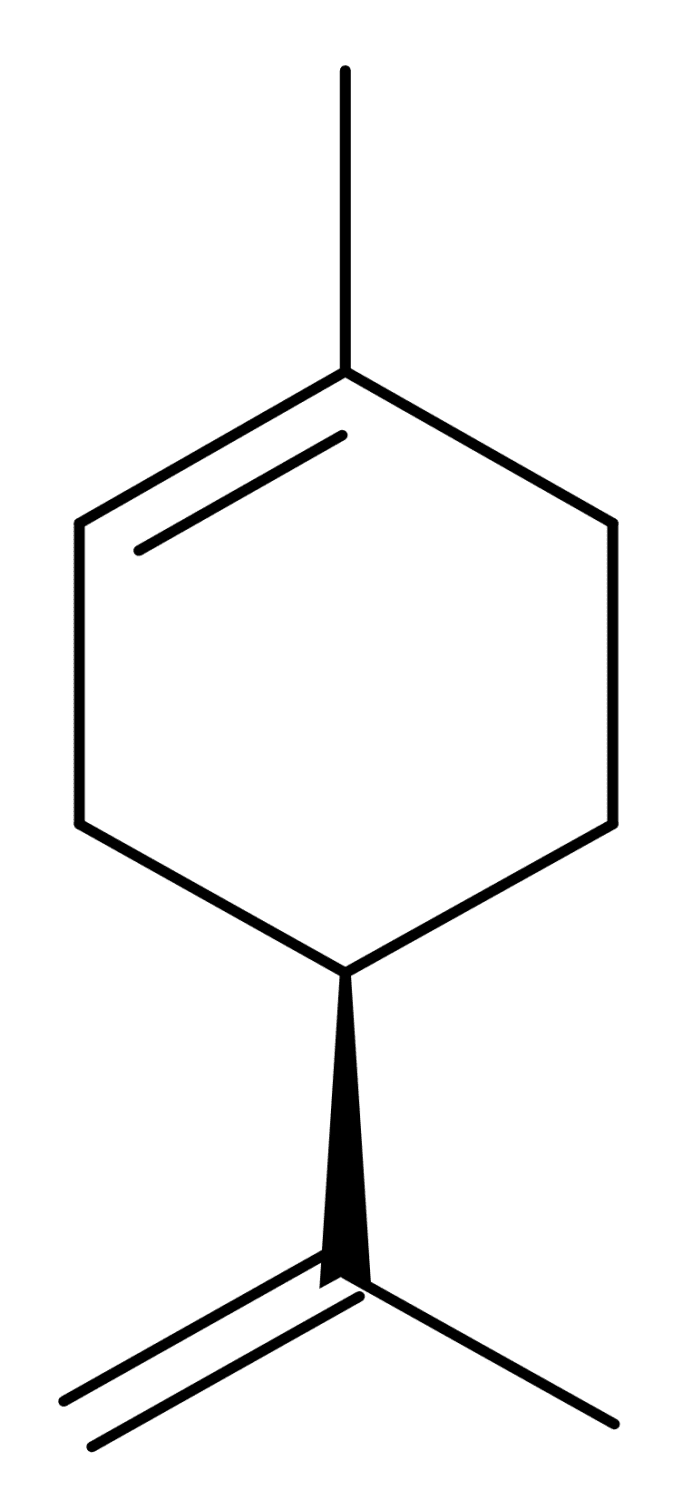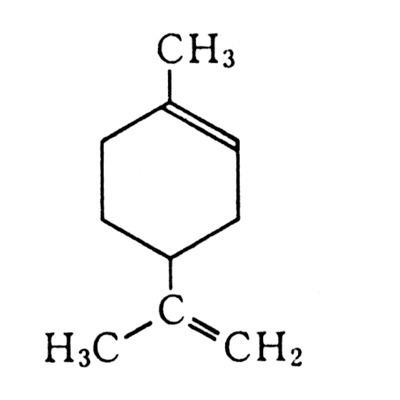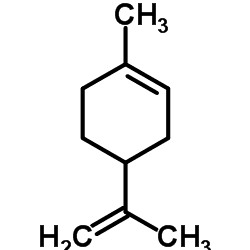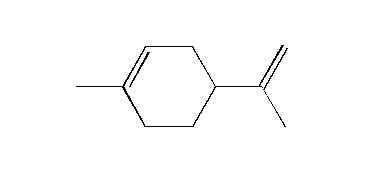Formula C10H16 Density 841 kg/m³ Melting point -74.35 °C | Boiling point 176 °C Molar mass 136.24 g/mol | |
 | ||
IUPAC ID 1-methyl-4-(1-methylethenyl)-cyclohexene Appearance colorless to pale-yellow liquid | ||
Organic chemistry lab demo isolation of limonene part 1
Limonene is a colorless liquid hydrocarbon classified as a cyclic terpene. The more common d-isomer possesses a strong smell of oranges. It is used in chemical synthesis as a precursor to carvone and as a renewables-based solvent in cleaning products. The less common l-isomer is found in mint oils and has a piney, turpentine-like odor.
Contents
- Organic chemistry lab demo isolation of limonene part 1
- Chemical reactions
- Biosynthesis
- Safety and research
- Uses
- Compendial status
- References

Limonene takes its name from the lemon, as the rind of the lemon, like other citrus fruits, contains considerable amounts of this compound, which contributes to their odor. Limonene is a chiral molecule, and biological sources produce one enantiomer: the principal industrial source, citrus fruit, contains d-limonene ((+)-limonene), which is the (R)-enantiomer. Racemic limonene is known as dipentene. d-Limonene is obtained commercially from citrus fruits through two primary methods: centrifugal separation or steam distillation.

Chemical reactions

Limonene is a relatively stable terpene and can be distilled without decomposition, although at elevated temperatures it cracks to form isoprene. It oxidizes easily in moist air to produce carveol, carvone, and limonene oxide. With sulfur, it undergoes dehydrogenation to p-cymene.

Limonene occurs commonly as the d or (R)-enantiomer, but racemizes to dipentene at 300 °C. When warmed with mineral acid, limonene isomerizes to the conjugated diene α-terpinene (which can also easily be converted to p-cymene). Evidence for this isomerization includes the formation of Diels-Alder adducts between α-terpinene adducts and maleic anhydride.

It is possible to effect reaction at one of the double bonds selectively. Anhydrous hydrogen chloride reacts preferentially at the disubstituted alkene, whereas epoxidation with mCPBA occurs at the trisubstituted alkene.
In another synthetic method Markovnikov addition of trifluoroacetic acid followed by hydrolysis of the acetate gives terpineol.
Biosynthesis
Limonene is formed from geranyl pyrophosphate, via cyclization of a neryl carbocation or its equivalent as shown. The final step involves loss of a proton from the cation to form the alkene.
The most widely practiced conversion of limonene is to carvone. The three step reaction begins with the regioselective addition of nitrosyl chloride across the trisubstituted double bond. This species is then converted to the oxime with base, and the hydroxylamine is removed to give the ketone-containing carvone.
Safety and research
d-Limonene applied to skin may cause irritation, but otherwise appears to be safe for human uses.
The enantiomers of perillyl alcohol have been investigated for their potential activities as chemotherapeutic agents, but there is no evidence for efficacy or regulatory approval for such clinical application as of 2017.
Uses
Limonene is common in cosmetic products. As the main odor constituent of citrus (plant family Rutaceae), d-limonene is used in food manufacturing and some medicines, e.g. as a flavoring to mask the bitter taste of alkaloids, and as a fragrance in perfumery, aftershave lotions, bath products and other such products that include fragrance; it is also used as botanical insecticide, the d enantiomer is most active as an insecticide. It is added to cleaning products such as hand cleansers to give a lemon-orange fragrance (see orange oil) and because of its ability to dissolve oils. In contrast, l-limonene has a piney, turpentine-like odor.
In natural and alternative medicine, d-limonene is marketed to relieve gastroesophageal reflux disease and heartburn.
Limonene is increasingly being used as a solvent for cleaning purposes, such as the removal of oil from machine parts, as it is produced from a renewable source (citrus oil, as a byproduct of orange juice manufacture). It is used as a paint stripper and is also useful as a fragrant alternative to turpentine. Limonene is also used as a solvent in some model airplane glues and as a constituent in some paints. All-natural commercial air fresheners, with air propellants, containing limonene are used by philatelists to remove self-adhesive postage stamps from envelope paper.
Limonene is also finding increased use as a solvent for filament-fused 3D printing. Printers can print the plastic of choice for the model, but erect supports and binders from HIPS, a polystyrene plastic that is easily soluble in limonene.
As it is combustible, limonene has also been considered as a biofuel.
In preparing tissues for histology or histopathology, d-limonene is often used as a less toxic substitute for xylene when clearing dehydrated specimens. Clearing agents are liquids miscible with alcohols (such as ethanol or isopropanol) and with melted paraffin wax, in which specimens are embedded to facilitate cutting of thin sections for microscopy.
d-Limonene is used in the organic herbicide "Avenger."
